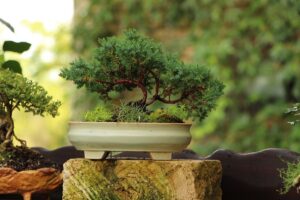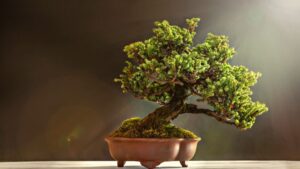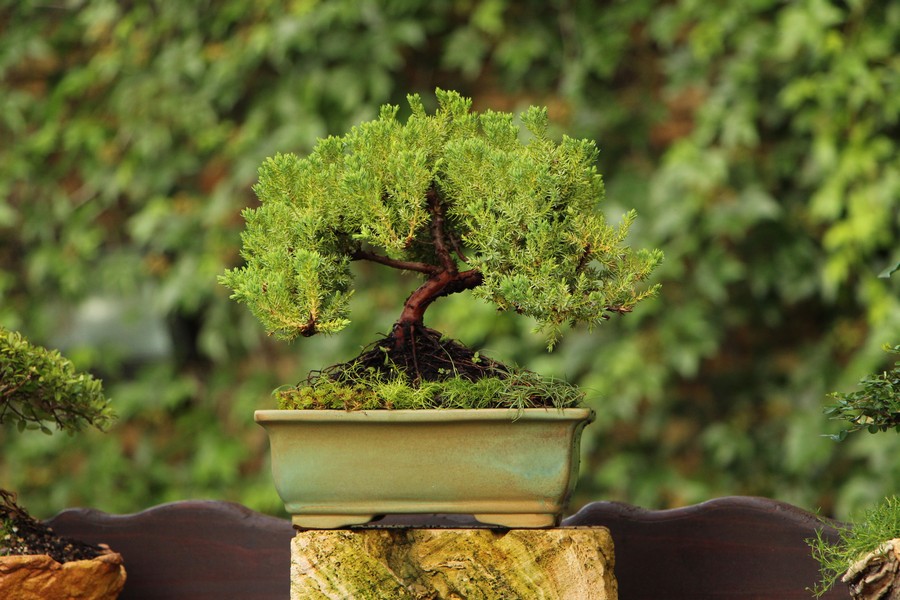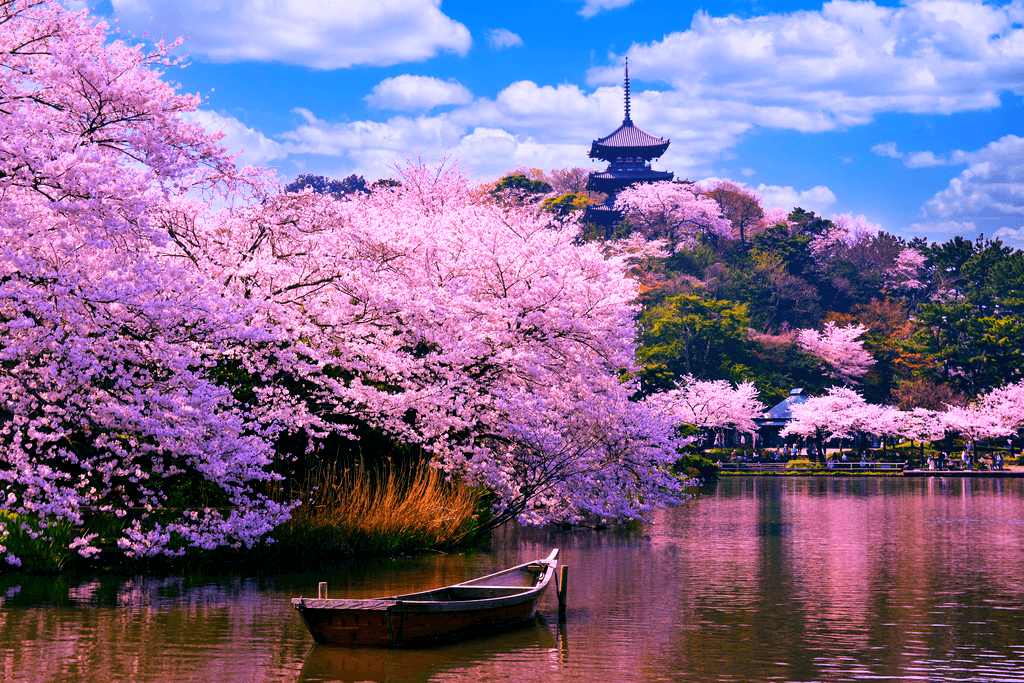Bonsai, originating from the Chinese term “penzai,” is an ancient horticultural art form that has captivated enthusiasts for centuries. The practice involves cultivating miniature trees and creating living sculptures that embody the essence of nature in a confined space. With roots in ancient China, bonsai evolved in Japan, where it gained its distinct characteristics and philosophical underpinnings. The art of bonsai requires a delicate balance between artistic vision and scientific understanding, making it a unique blend of aesthetics and horticultural expertise. If you want to travel to Japan you can rent a vehicle from rent a car Beograd.
The meticulous cultivation of bonsai involves shaping and pruning to mimic the appearance of full-sized trees in nature. Artists carefully select tree species, considering their growth patterns and aesthetic potential. Patience is a virtue in bonsai cultivation, as it may take years, even decades, for a tree to mature into a true masterpiece. This intersection of patience and artistic expression forms the core of the art, where each carefully crafted bend and twist in the tree’s form tells a story of the passage of time.
Bonsai’s allure lies not only in its visual appeal but also in the profound connection it fosters between the artist and nature. As practitioners immerse themselves in the art, they learn to observe and understand the nuances of the trees they cultivate, gaining insight into the delicate balance of life and growth. The art of bonsai, therefore, transcends mere horticulture; it becomes a meditative practice, offering a window into the beauty of the natural world on a miniature scale.
If you want to start a blog about growing bonsai you should find the best web hosting providers for your website.
The Science Behind Bonsai Mastery

While bonsai is undoubtedly an art form, its mastery requires a deep understanding of the underlying scientific principles governing plant growth. Bonsai artists delve into the realms of horticulture, botany, and arboriculture to ensure the health and vitality of their miniature creations. Soil composition, watering schedules, and exposure to sunlight are meticulously controlled, with each factor playing a crucial role in the tree’s development. If you want to buy a house with a backyard so you can enjoy growing bonsai you can contact one of the mortgage companies in Raleigh NC.
One of the key scientific principles in bonsai cultivation is the concept of “training” the tree. Through precise pruning techniques, artists guide the growth of the bonsai, coaxing it into the desired shape. This process not only enhances the aesthetic appeal but also promotes the tree’s overall health. Understanding the biology of trees is essential, as different species exhibit varied responses to pruning and environmental conditions. The mastery of these scientific nuances empowers bonsai practitioners to create harmonious compositions that echo the beauty of nature.
To grow bonsai inside you need to have proper HVAC systems. You can contact a company that provides HVAC repair in Charlotte NC to help you with that.
The artful combination of science and aesthetics is evident in the meticulous care given to the roots of bonsai trees. Root pruning is a delicate operation that requires finesse and a deep understanding of the tree’s vitality. By carefully trimming the roots, artists control the tree’s size and promote a compact, balanced growth. This scientific approach ensures the longevity of the bonsai, allowing it to thrive in a confined space while maintaining its miniature grandeur.
If you need a loan for your bonsai garden you will have to fill out a form 1098.
Cultivating Bonsai: A Patient Pursuit
Central to the art and science of bonsai is the virtue of patience. Cultivating these miniature masterpieces demands a long-term commitment, testing the patience and dedication of practitioners. Bonsai artists learn to embrace the gradual transformation of their trees, understanding that true beauty unfolds slowly over time. This patient pursuit aligns with the philosophical underpinnings of bonsai, where the journey of cultivation is as significant as the final aesthetic result.
The seasons play a vital role in the life of a bonsai tree, influencing its growth patterns and aesthetic characteristics. Practitioners keenly observe the changing seasons, adjusting their care routines accordingly. Winter dormancy, spring blossoms, and the vibrant hues of autumn all contribute to the dynamic narrative of a bonsai’s existence. Patience becomes a form of mindfulness, as artists attune themselves to the rhythm of nature, celebrating each season as a chapter in the ongoing story of their miniature masterpiece.
In the world of bonsai, the passage of time is not a hindrance but a transformative force. As the tree evolves, so does the artist, gaining wisdom and insight with each passing year. The patient pursuit of bonsai cultivation is a testament to the enduring relationship between the artist and the living sculpture they create—a relationship that transcends time and embraces the beauty of the evolving, miniature landscape.
If you are keeping your bonsai inside be sure to buy window shutters in Utah because sometimes bonsai needs less Sun.
Nurturing Creativity: Bonsai as a Therapeutic Pursuit
Beyond its aesthetic and horticultural dimensions, bonsai has found a new frontier as a therapeutic pursuit. The meditative nature of cultivating these miniature trees provides practitioners with a form of creative expression that goes beyond the visual appeal of the final masterpiece. Bonsai becomes a vehicle for self-discovery and mindfulness, offering a therapeutic escape from the stresses of modern life.
The act of tending to a bonsai tree demands a focused and present mindset. As individuals immerse themselves in the intricate details of pruning, wiring, and shaping, they enter a state of flow—a psychological state characterized by intense concentration and a sense of timelessness. This meditative aspect of bonsai aligns with the principles of mindfulness, providing practitioners with a respite from the hustle and bustle of daily life.
Besides bonsai, Japan is famous for having beautiful lakes where you can go fishing. Be sure to check a fishing app before your trip to make sure that the weather is perfect.
Therapeutic horticulture programs have embraced bonsai cultivation as a means of promoting mental well-being. The tactile engagement with the soil, the rhythmic motion of pruning, and the visual appreciation of the evolving tree contribute to a holistic sensory experience. Bonsai practitioners often describe a profound sense of connection with nature and self, fostering a therapeutic journey that transcends the boundaries of traditional art forms.
Beyond personal well-being, therapeutic bonsai cultivation has demonstrated positive effects on community dynamics. Group bonsai projects bring people together, fostering a sense of camaraderie and shared accomplishment. The collaborative effort required to create and maintain a bonsai garden becomes a metaphor for community resilience and the strength derived from unity. In this way, bonsai transcends its role as a solitary art form and becomes a catalyst for social connection and support.
If you want to buy a bonsai business you can contact M&A advisory firms.
Bonsai and the Digital Age: Virtual Gardens and Online Communities

In the age of technology, bonsai has found a place in the digital realm, expanding its reach and influence. Virtual bonsai gardens, facilitated through online platforms and social media, have become spaces for enthusiasts to share their creations, exchange knowledge, and connect with like-minded individuals globally. The digital landscape has given rise to a virtual bonsai community that transcends geographical limitations, allowing practitioners to showcase their work and seek inspiration from diverse sources.
Online tutorials, live demonstrations, and virtual exhibitions have become integral components of the bonsai experience. Aspiring artists can now access a wealth of information and guidance at their fingertips, learning from seasoned practitioners and expanding their skills through online workshops. These workshops are always hosted by a renowned seminar emcee. The digital age has democratized bonsai education, making it accessible to a broader audience and fostering a culture of continuous learning and improvement.
Social media platforms serve as virtual galleries where bonsai enthusiasts proudly display their creations, sparking conversations and sharing insights. The instantaneous nature of online communication allows for real-time feedback and collaboration, creating a dynamic and interactive space for the global bonsai community. The fusion of traditional practices with modern technology has not only preserved the essence of bonsai but has also propelled it into the future as a living, evolving art form.
If you decided to travel to Japan and you need transport to the airport you can use the Airport Limo Service in Atlanta.
Bonsai Conservation: Preserving Natural Beauty on a Small Scale
In an era marked by environmental awareness and conservation efforts, bonsai has emerged as a unique contributor to the preservation of biodiversity. Bonsai cultivation involves the propagation and care of various tree species, including those that might be endangered or threatened in their natural habitats. Bonsai artists, often inadvertently, become stewards of rare and exotic plants, contributing to the conservation of species that face challenges in the wild. If you need more security for your bonsai garden you can contact a company that provides business security in Los Angeles.
Botanical gardens and arboreta worldwide recognize the value of bonsai in preserving genetic diversity. Bonsai collections within these institutions serve as living archives, showcasing the beauty of diverse tree species and raising awareness about the importance of conservation. The miniature landscapes created by bonsai artists become ambassadors for the natural world, highlighting the need to protect and appreciate the intricate ecosystems that sustain life on Earth.
Bonsai conservation efforts extend beyond the cultivation of individual trees to include educational initiatives. Bonsai exhibitions and outreach programs educate the public about the significance of preserving biodiversity and the role that each individual can play in environmental stewardship. The intimate connection between the artist and the miniature tree becomes a powerful metaphor for humanity’s interconnectedness with the broader ecosystem, reinforcing the message of conservation on a small scale with profound implications.
If you want to open a store to sell bonsai trees you will have to consult with a business litigation expert witness.
Bonsai Innovations: Pushing the Boundaries of Tradition

While bonsai is deeply rooted in tradition, contemporary artists are pushing the boundaries of convention, introducing innovative techniques and materials to the art form. Experimentation with unconventional tree species, non-traditional containers, and avant-garde styling approaches has redefined the possibilities within bonsai. This spirit of innovation injects a dynamic energy into the art, ensuring its relevance and evolution in the face of changing artistic sensibilities.
If you want to boost sales of your bonsai you can hire a promotional products supplier.
Artists are exploring alternative methods of shaping and training bonsai, incorporating modern tools and technologies into the process. 3D printing, for example, allows for the creation of intricate and customized containers, adding a futuristic dimension to the presentation of bonsai. These innovations not only expand the artistic palette but also attract a new generation of enthusiasts who resonate with the fusion of tradition and modernity.
Contemporary bonsai exhibitions often feature avant-garde displays that challenge preconceived notions of what a bonsai should be. Artistic freedom and individual expression are celebrated, ushering in an era where the boundaries between bonsai and other art forms blur. This willingness to embrace innovation ensures that bonsai remains a dynamic and living art, capable of surprising and captivating audiences well into the future.
Bonsai and the Circle of Life: A Metaphor for Transience
At its core, bonsai encapsulates the profound philosophy of transience—the impermanence of all things. The life cycle of a bonsai, from a tiny sapling to a meticulously crafted masterpiece, mirrors the journey of life itself. Bonsai artists, attuned to the cycles of growth and seasonal changes, find solace in the transient beauty of their creations, understanding that each phase contributes to the overall narrative of the tree.
The art of bonsai invites contemplation on the nature of existence, prompting practitioners to embrace the fleeting moments of beauty and change. As the bonsai undergoes its natural cycles, from the vibrant blossoms of spring to the serene dormancy of winter, it becomes a metaphor for the ebb and flow of life. This deep philosophical underpinning elevates bonsai beyond mere aesthetics, transforming it into a profound reflection on the human experience.
In the hands of skilled artists, bonsai transcends time and space, capturing the essence of the eternal cycle of life and death. The continual evolution of the tree becomes a visual representation of the interconnectedness of all living things, resonating with individuals on a spiritual level. Bonsai, in its silent eloquence, becomes a conduit for contemplating the mysteries of existence and finding beauty in the ever-changing tapestry of life.
If you want to drive around Japan and learn from locals how to grow bonsai you can rent a Denver limousine.



